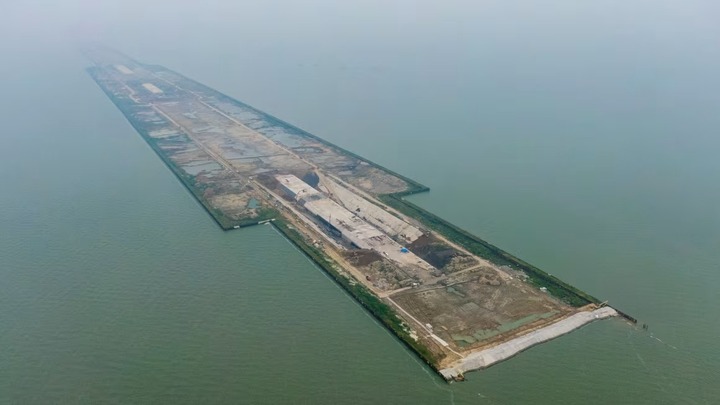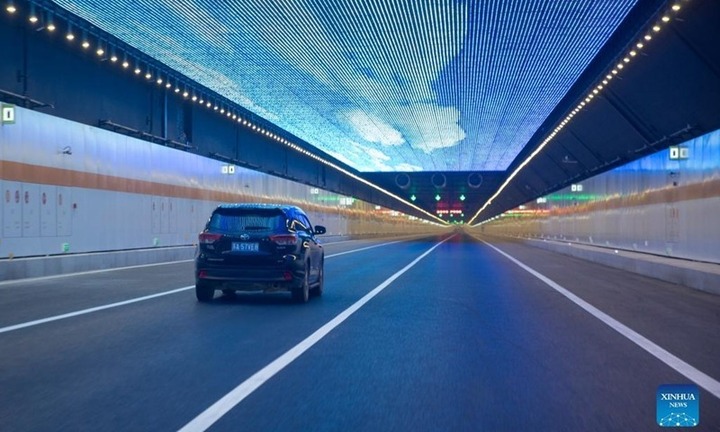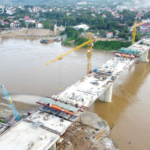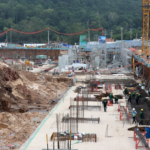A Social Media Sensation: The Taihu Tunnel
The stunning Taihu Tunnel, a new highway tunnel connecting Shanghai and Nanjing, has taken social media by storm. With its vibrant LED lights and unique spiral-shaped waiting area floating on the water, it has become a popular destination for tourists and locals alike.
Besides being the second highway between Shanghai and Nanjing, the tunnel has also increased tourism by 50% to famous scenic spots such as Lingshan and Nianhua Bay. It has been dubbed a “special tourist route.”
With a total length of 10.79 km, the tunnel is a key project on the Suzhou-Wuxi-Changzhou Expressway. It officially opened to traffic on December 30, 2021, becoming one of the longest underwater tunnels in China.

An aerial view of the Taihu Tunnel in Jiangsu Province, East China, taken on September 5, 2021. (Xinhua)
Innovative Construction Techniques
Taihu Lake, the third-largest freshwater lake in China, has over 50 inflowing and outflowing rivers. Due to the soft clay accumulated on the lake bed over thousands of years, traditional drilling methods like shield tunneling could not be used.
After careful consideration, engineers opted for the cofferdam method, which involves building a dry area in the middle of the lake by constructing retaining walls, essentially turning the lake bed into temporary land for construction.
To minimize disruption to navigation, the 10-km tunnel was divided into nine cofferdam sections. Once each section was completed, the construction team backfilled the area, pumped out the water, and restored the lake to its original state.
The Mashan section of the tunnel required an enormous amount of concrete, totaling 1 million cubic meters, with the deepest part located 20 meters below the lake bed. As it was entirely underwater, waterproofing was a critical concern. The engineers employed creative solutions to address this challenge.
A dedicated research group was formed to tackle the common issues with large-volume concrete construction in hot weather conditions. They devised methods to minimize cracking and internal defects while improving the smoothness and aesthetics of the concrete surface.
To prevent the concrete from overheating during curing (which can cause cracks), the team used ice machines to cool the concrete mix, allowing for better temperature control. Additionally, they embedded thin optical fibers within the concrete to monitor temperature and vibration in real time, ensuring precise and timely quality control.

The tunnel in operation. (Xinhua)
Taking it a step further, they automated the steel production and concrete component manufacturing processes, incorporating robotics for sorting and machining. This not only reduced manual labor but also enhanced product accuracy. A closed-loop, modern concrete mixing station was also established, integrating digital technology, mechanical engineering, and artificial intelligence.
These innovative technologies helped cultivate a highly skilled team of engineers and workers, elevating the construction standards to modern industrial levels.
Prioritizing Ecological Preservation
The construction site, located near Taihu Lake, is a diverse ecological area with 15 species of fish and abundant plankton. It is also a traditional aquaculture area. On the shore, the project is adjacent to the Taihu-Wuxi National Tourist Resort, which boasts a 70% green coverage rate and two tourist spots.
To minimize ecological impact, the construction team installed a V-shaped conveyor belt over 700 meters long and 6 meters high to transport sand and stones from the temporary wharf to the mixing station 200 meters away. Four water cannons were used to spray mist and control dust during the filling process.
Steel sheet piles were used during pile driving to reduce noise and environmental impact. Grease and wastewater from the machinery repair area were centrally collected and treated, with no discharge into the lake.
Additionally, the construction team took the initiative to clean up litter around the lake and in nearby communities, minimizing negative impacts on the environment and fisheries.
The Taihu Tunnel has played a pivotal role in enhancing the Shanghai-Nanjing traffic network and has become a new driver for economic growth in the entire Yangtze River Delta region.
“Qualcomm Awards $225,000 to 3 Outstanding Startups at QVIC 2025”
Qualcomm has just announced the winners of the 2025 Qualcomm Vietnam Innovation Challenge (QVIC), celebrating exceptional tech startups and marking five years of fostering a vibrant innovation ecosystem in Vietnam.
The Ultimate Smartphone Showdown: How Samsung’s New Model Finally Outshines the iPhone
The data reveals a startling fact: the most popular iPhone model today is the iPhone 13, released back in 2021. This is a worrying statistic for Apple.
Get Ready for the APEC 2027: Major Projects to Commence in September
With APEC 2027 on the horizon, there’s a renewed sense of urgency to accelerate the development of key projects and infrastructure on the beautiful island of Phu Quoc. Embodying a spirit of diligence and accountability, the island is transforming itself into a bustling hub, ensuring that no delays hinder its progress.













































